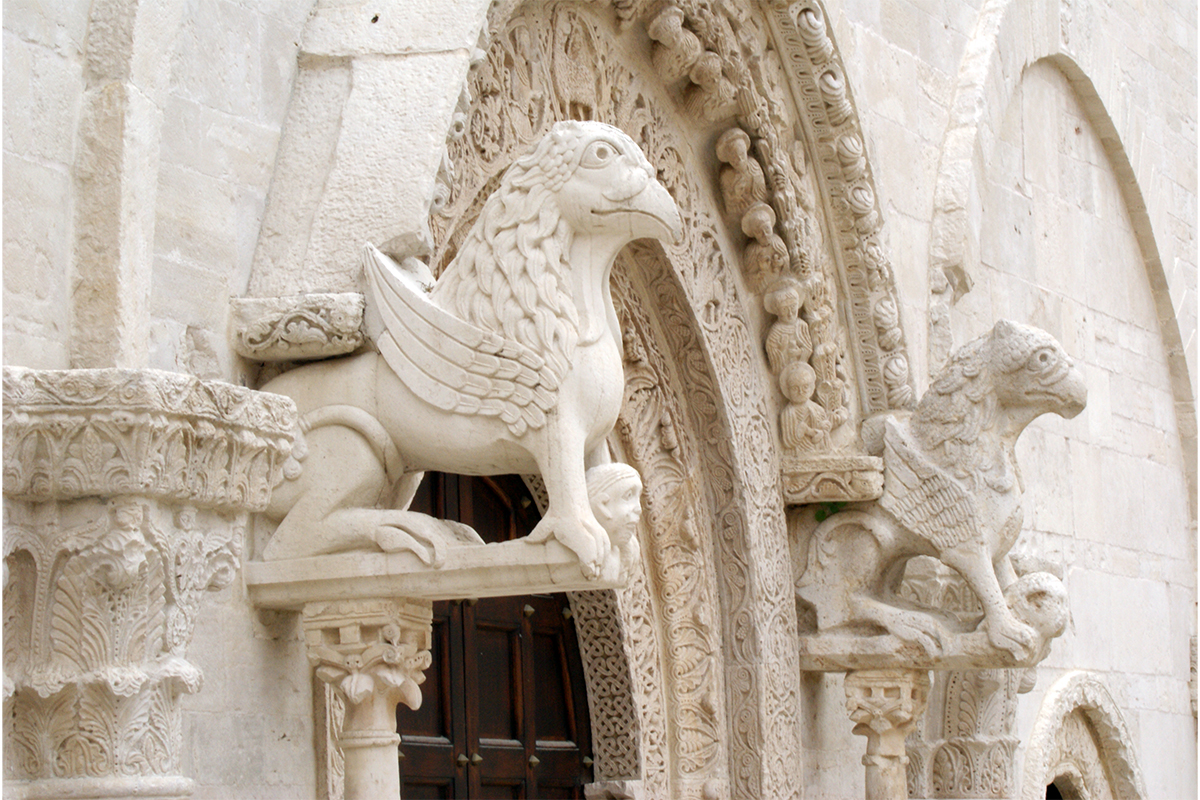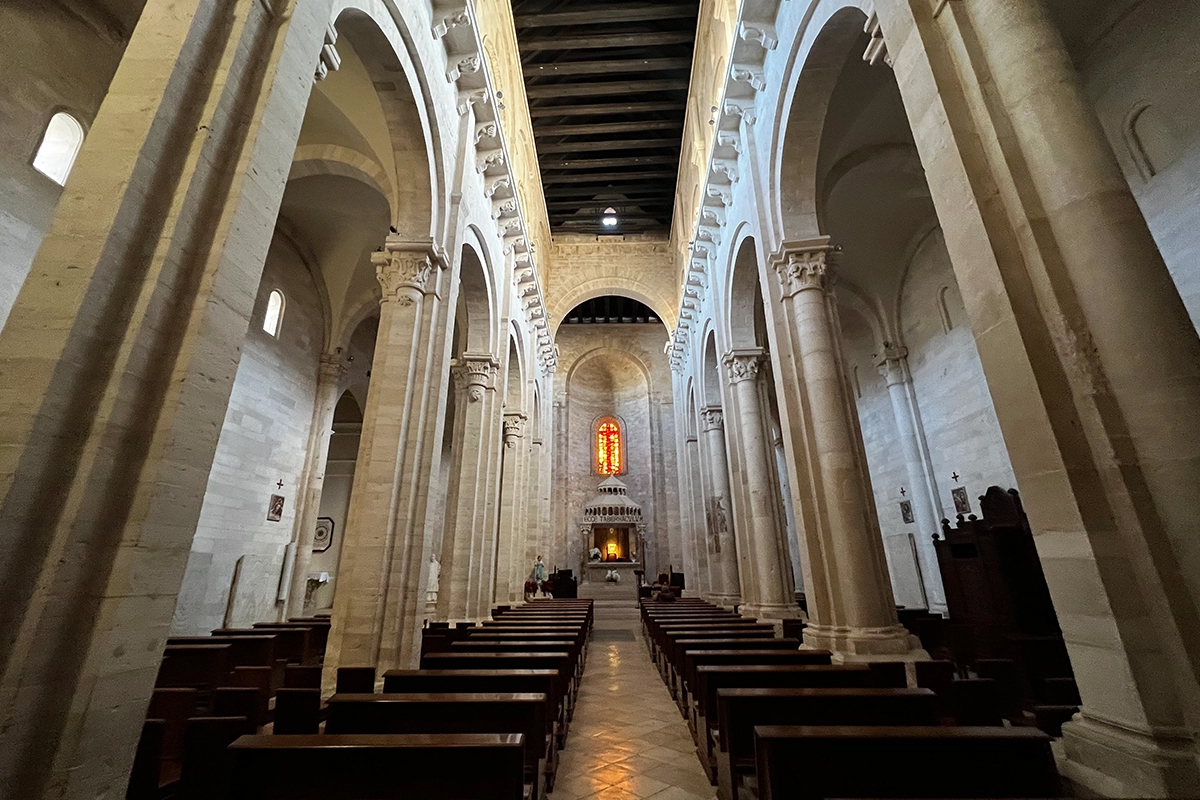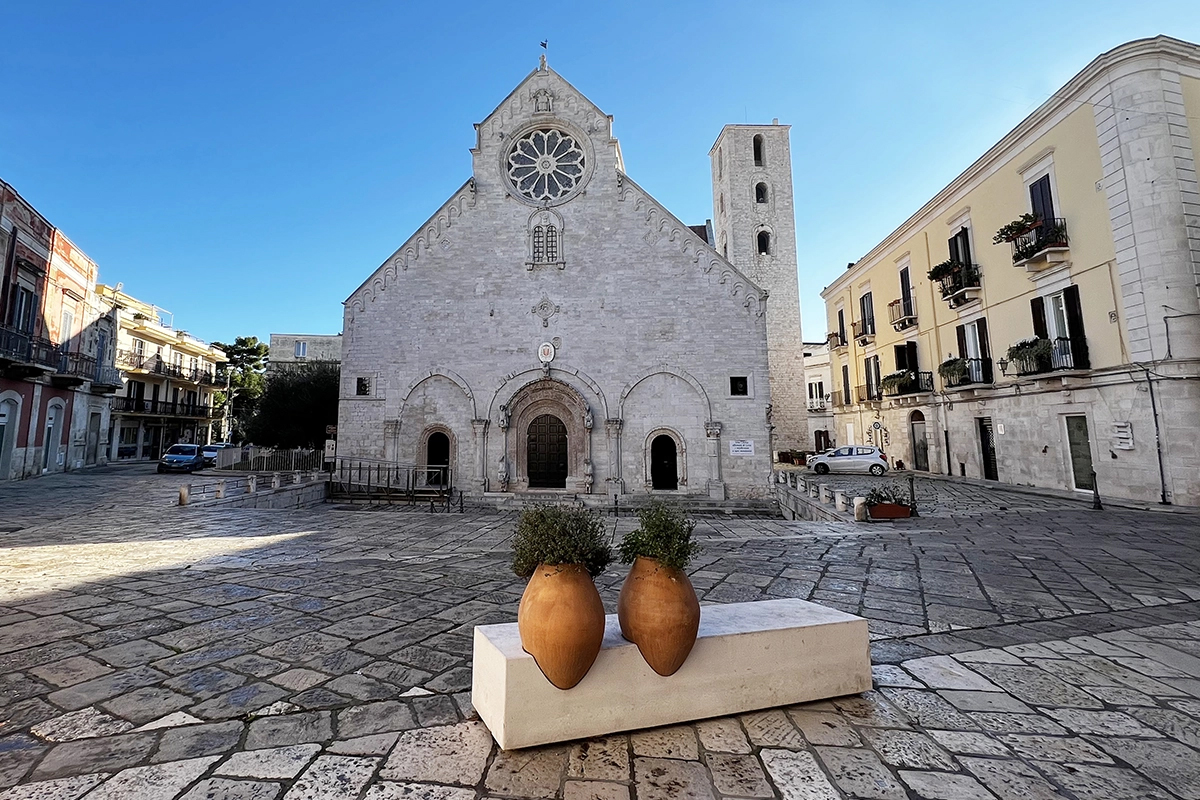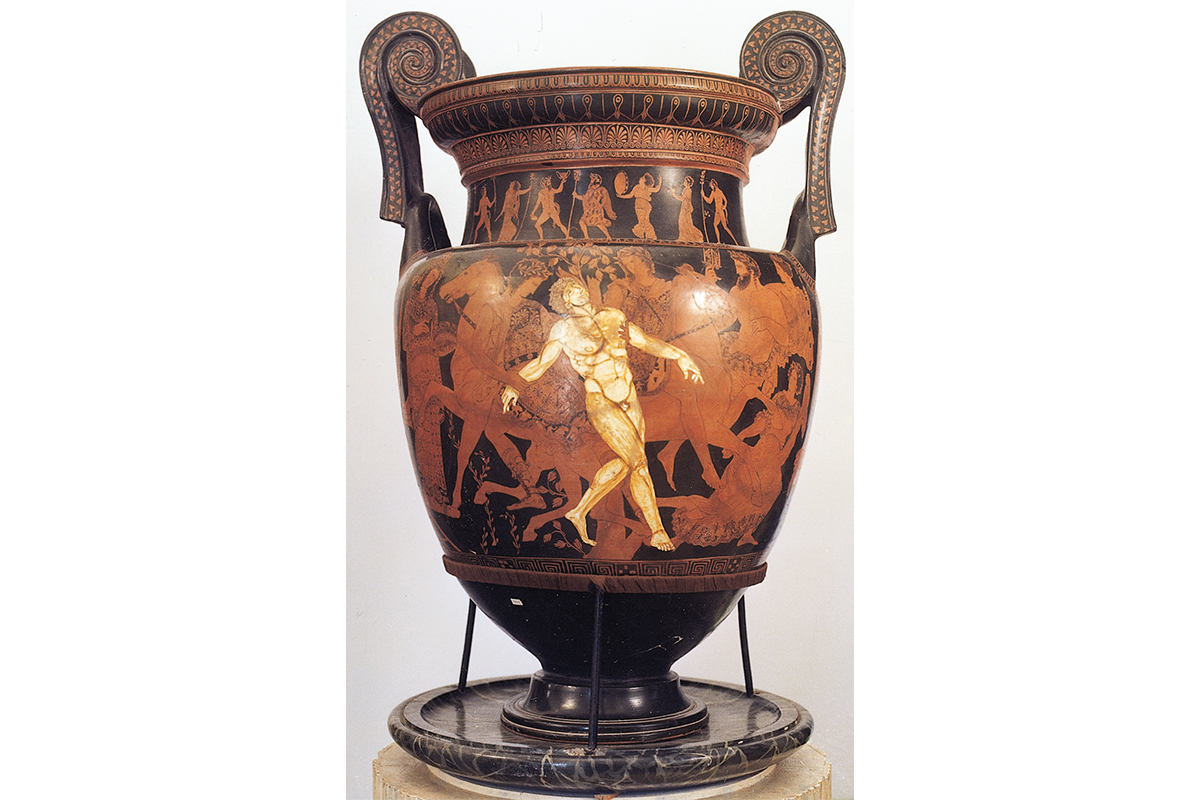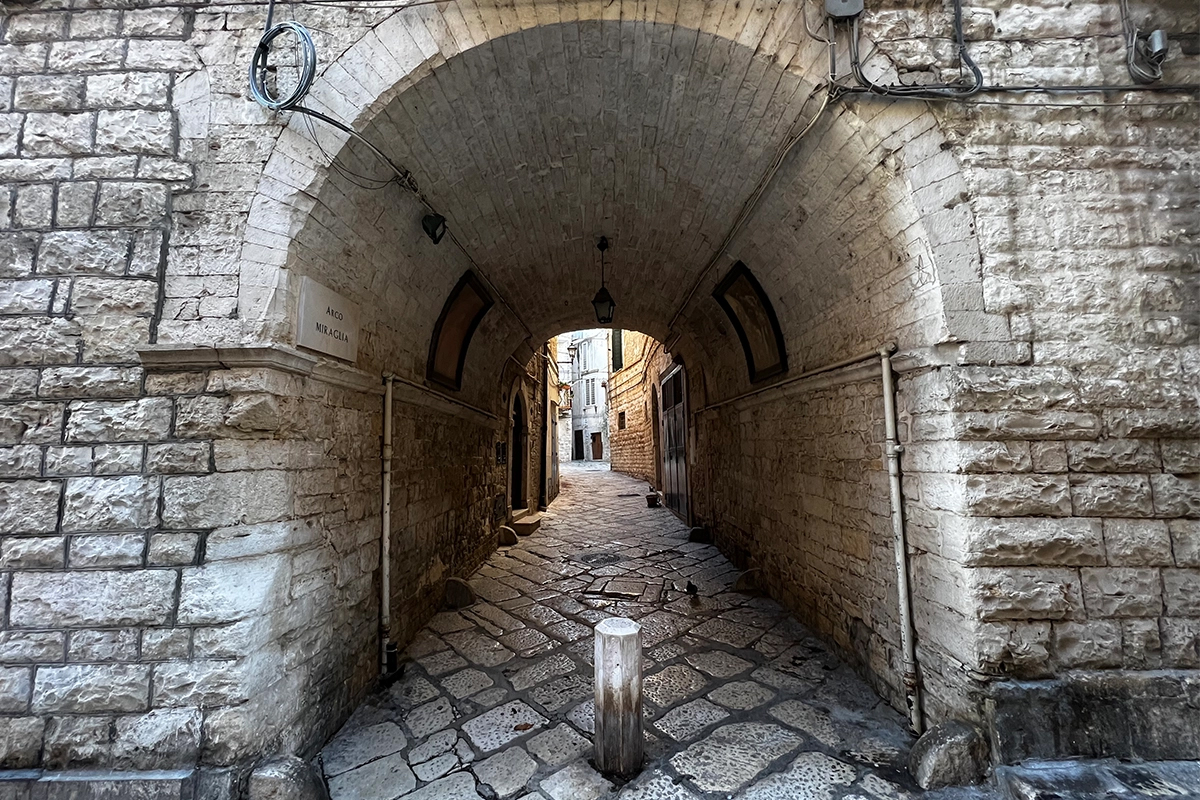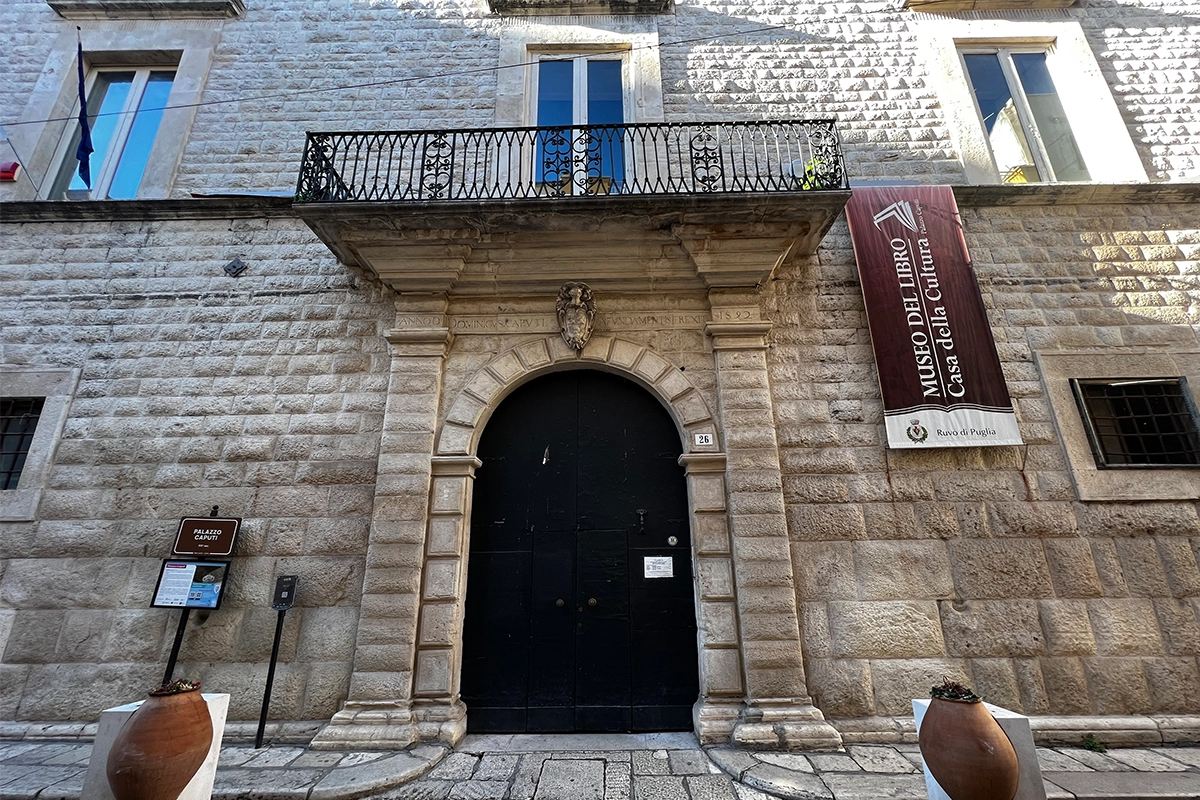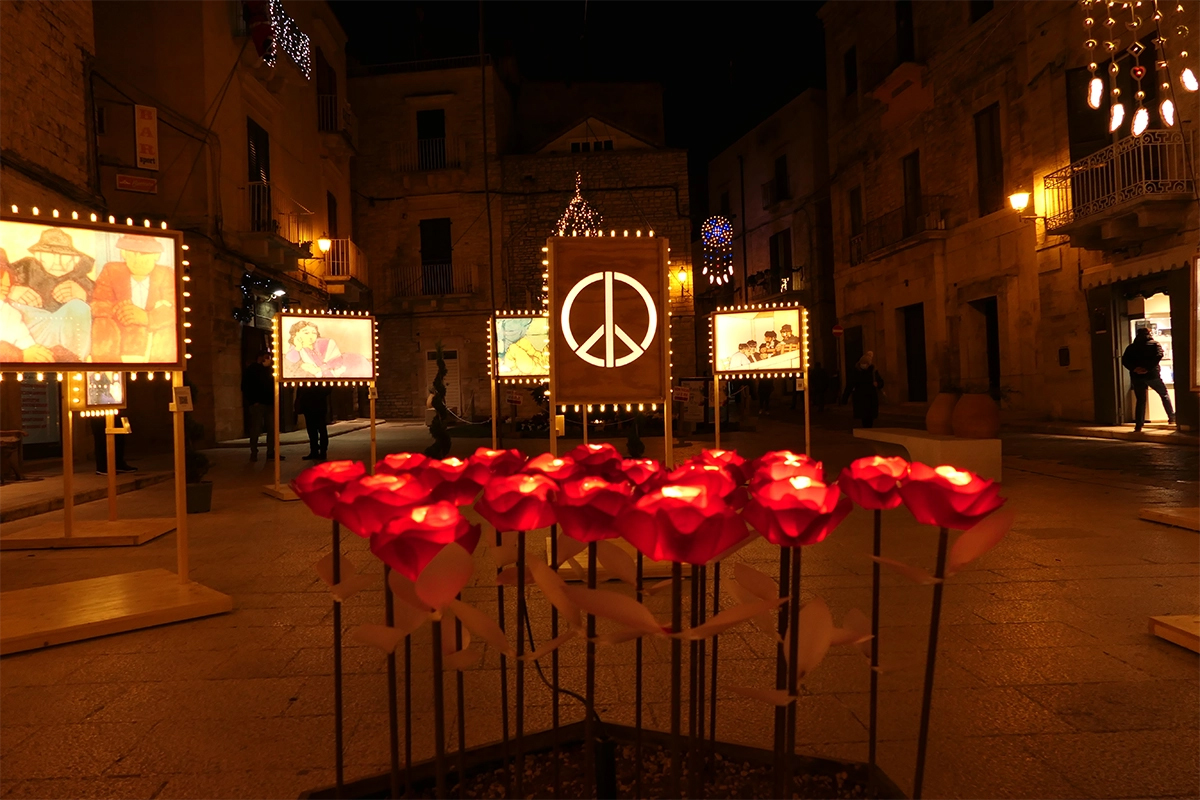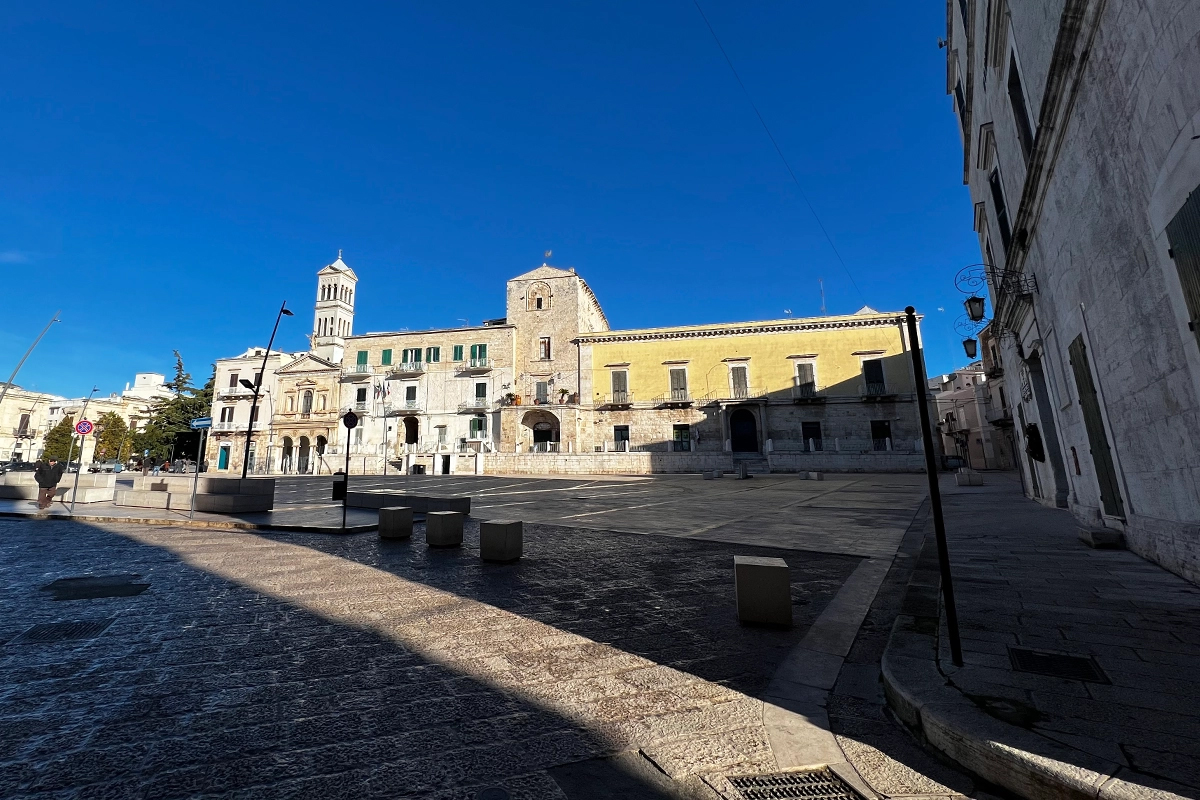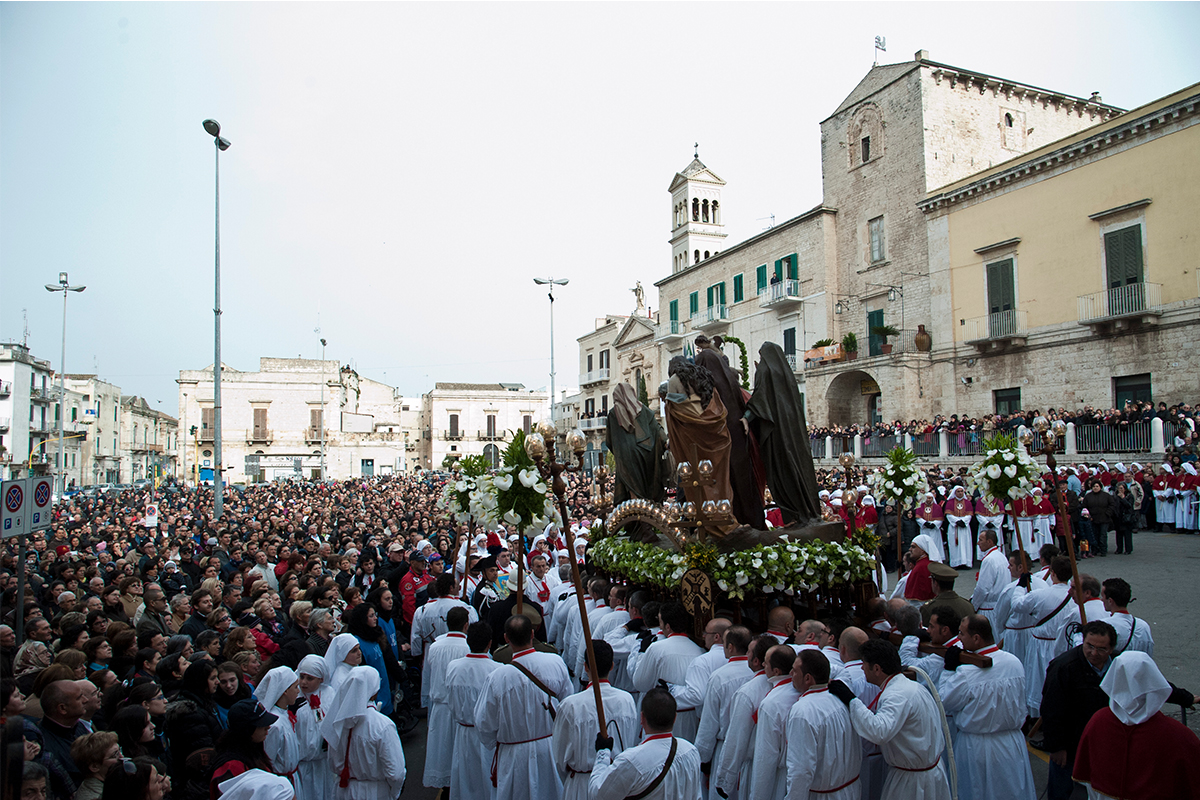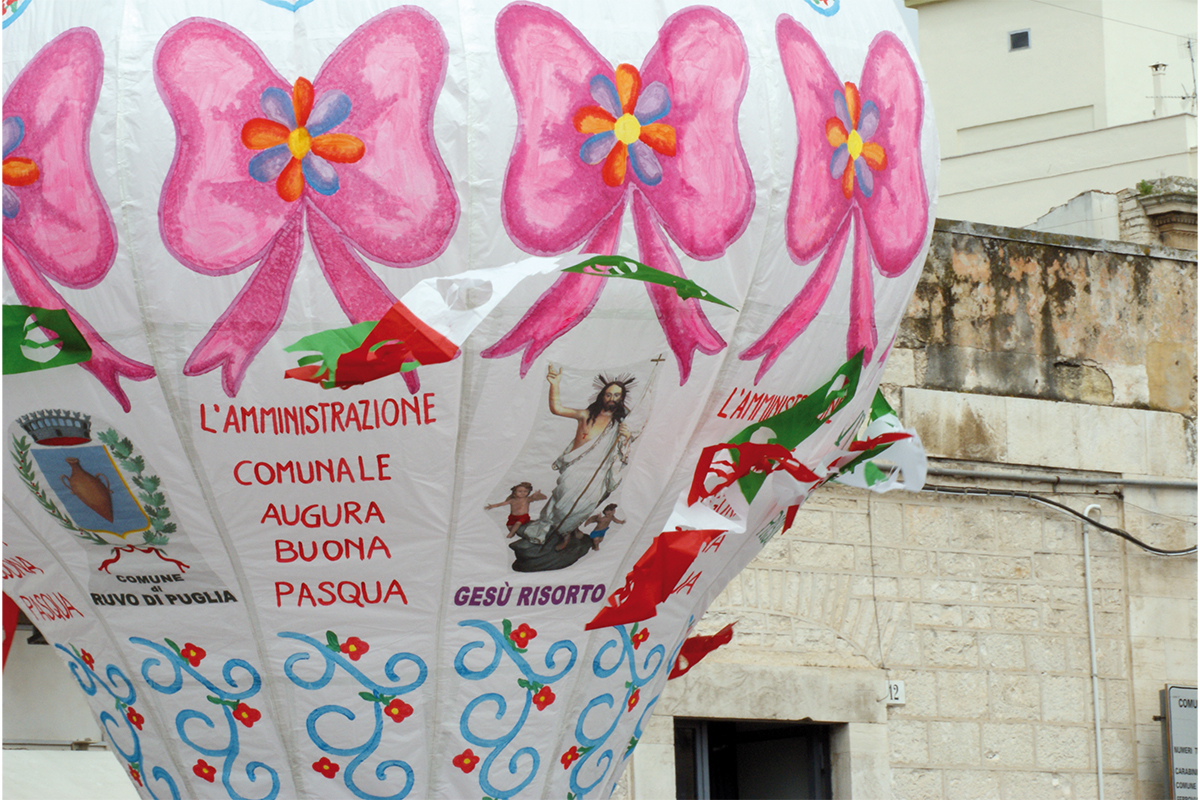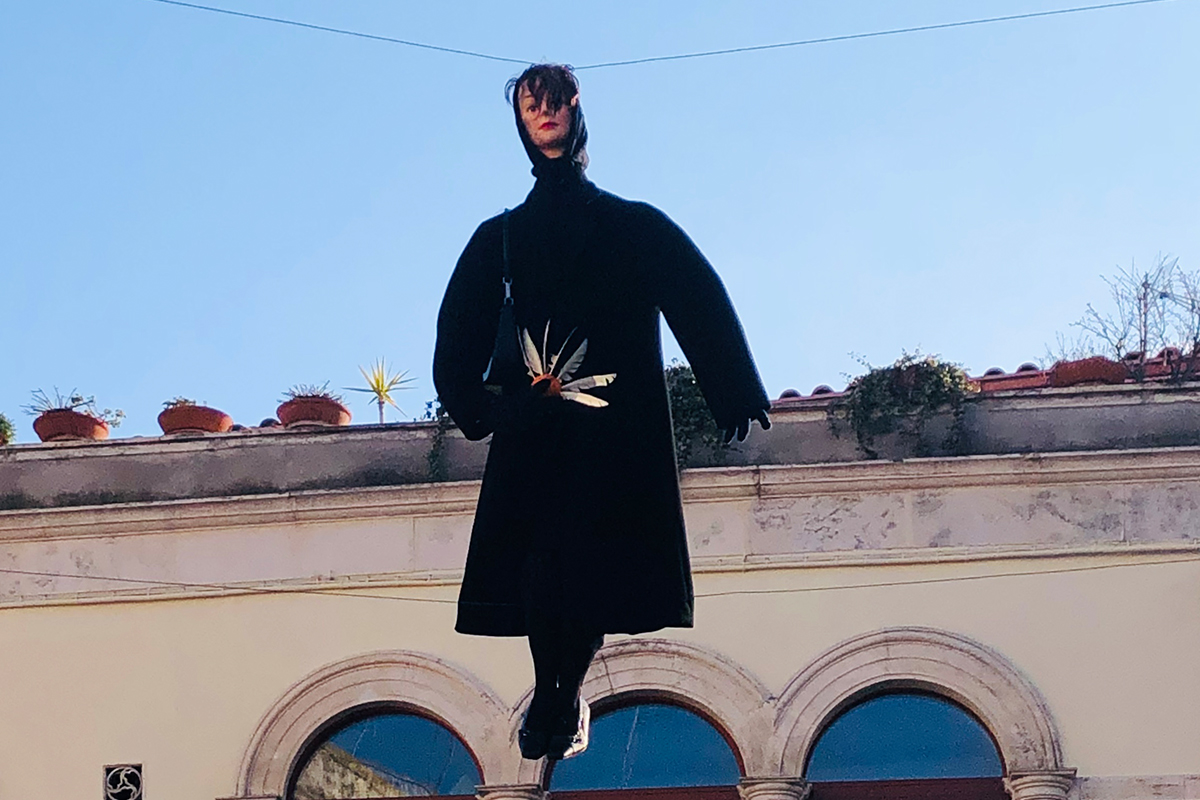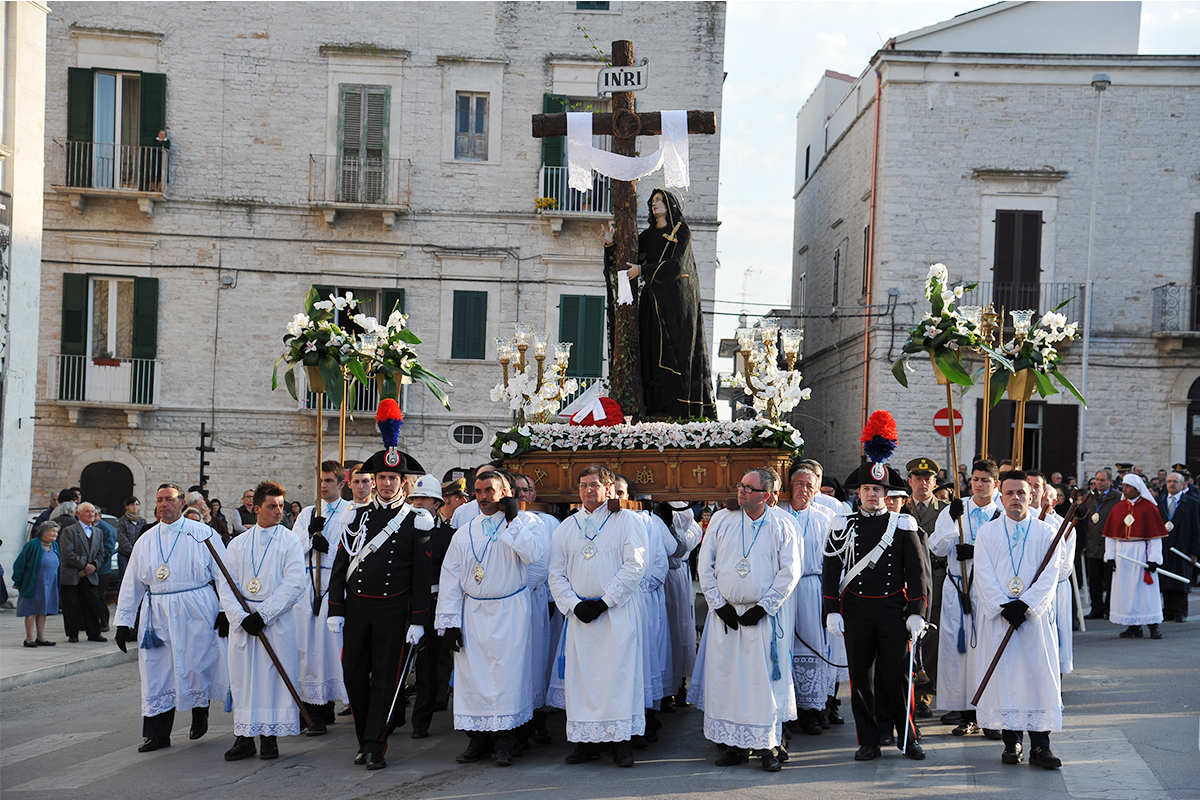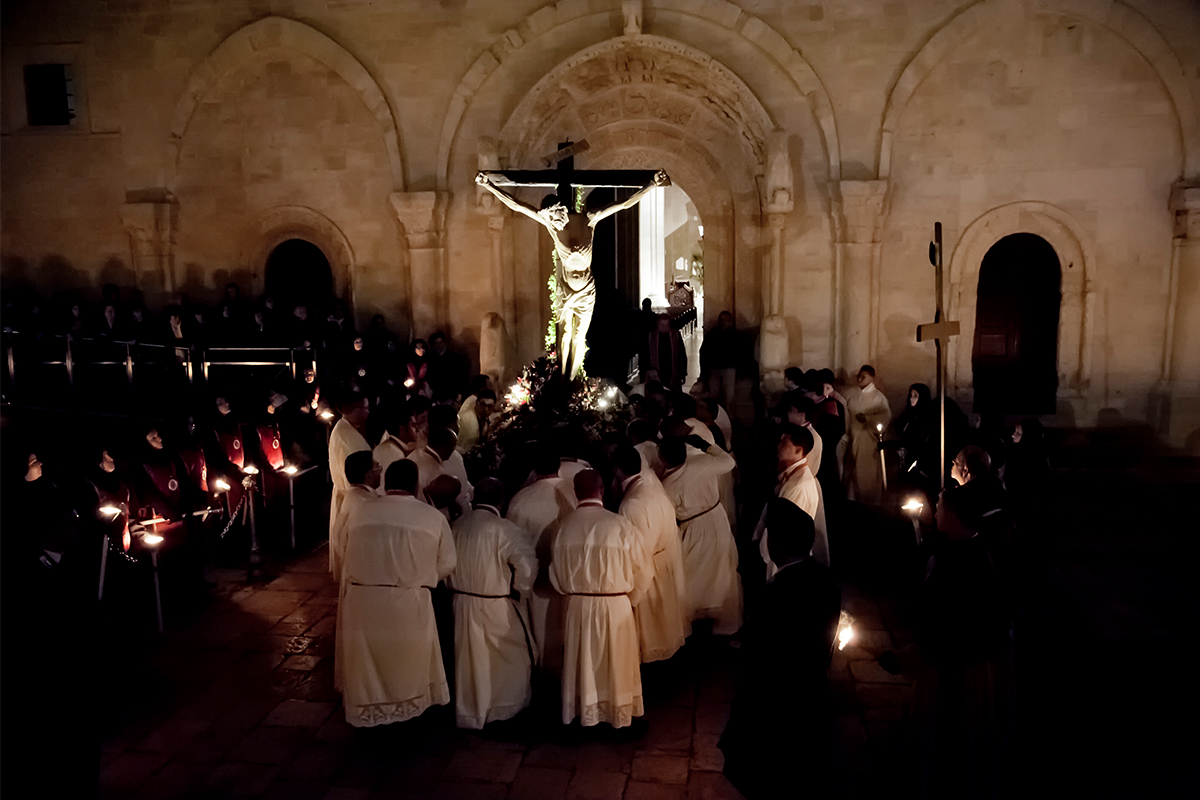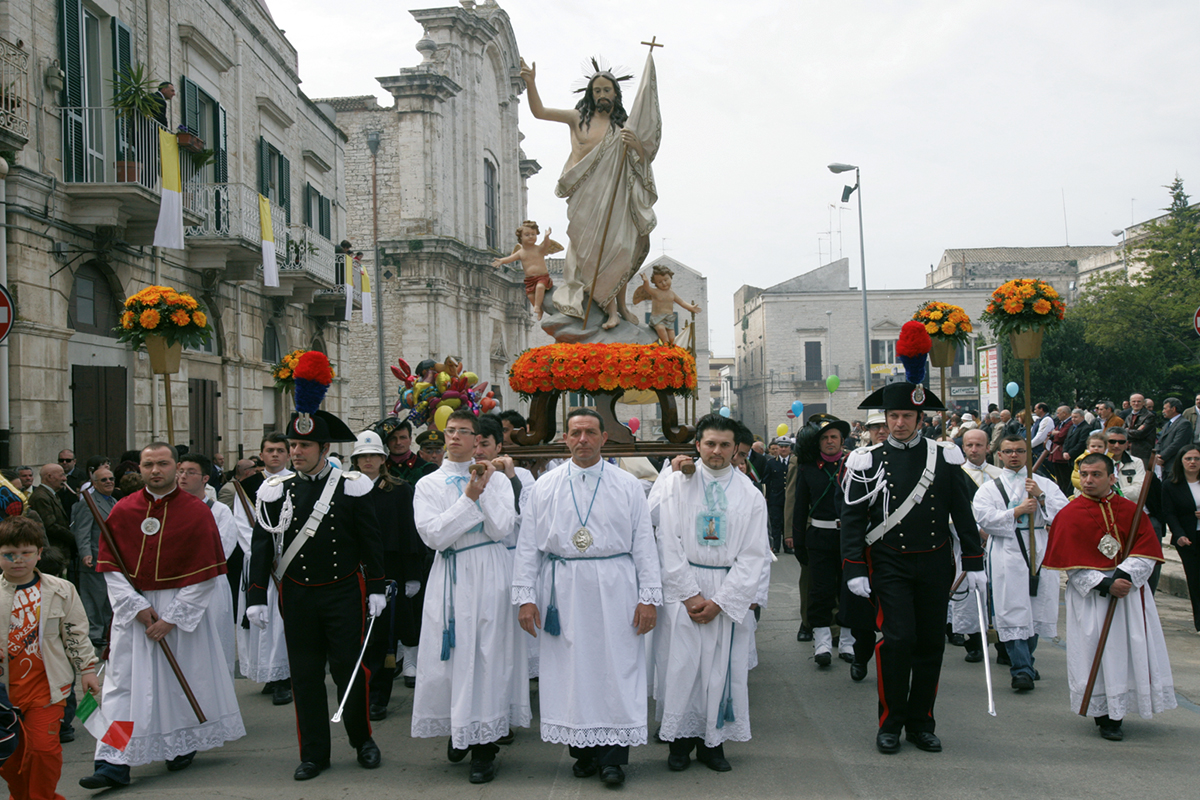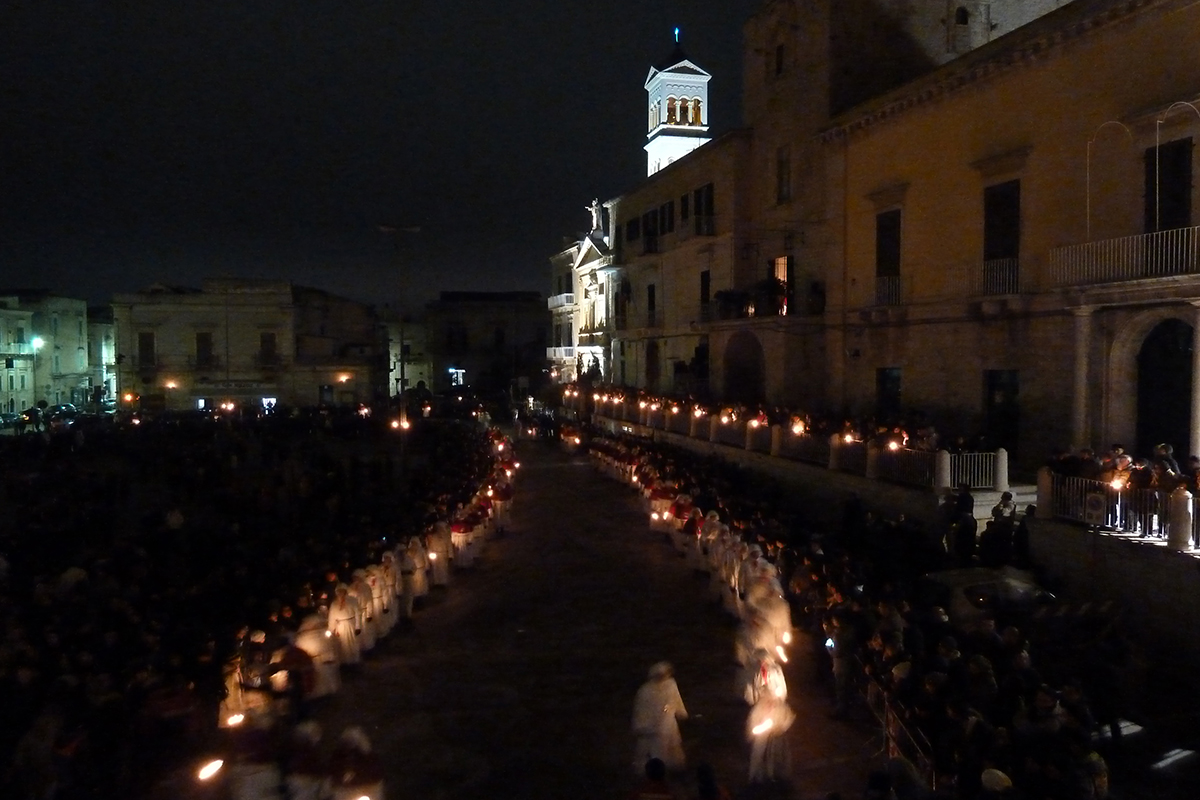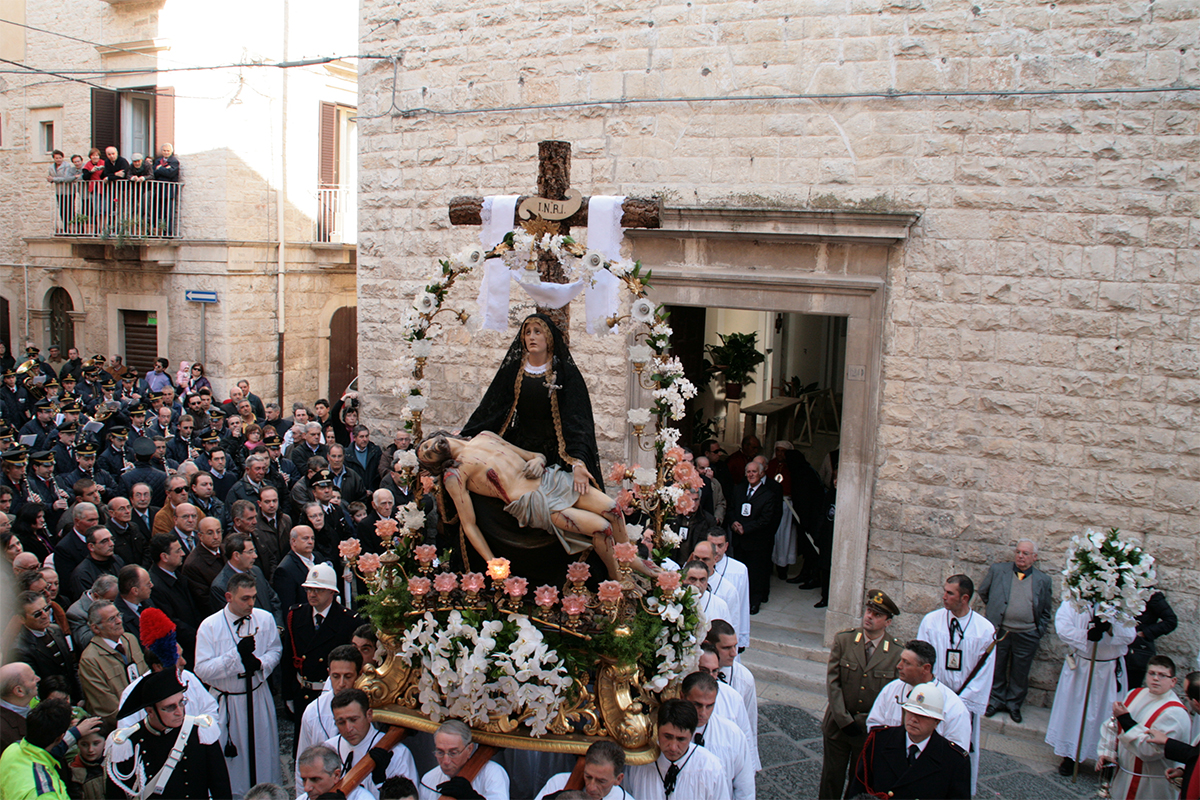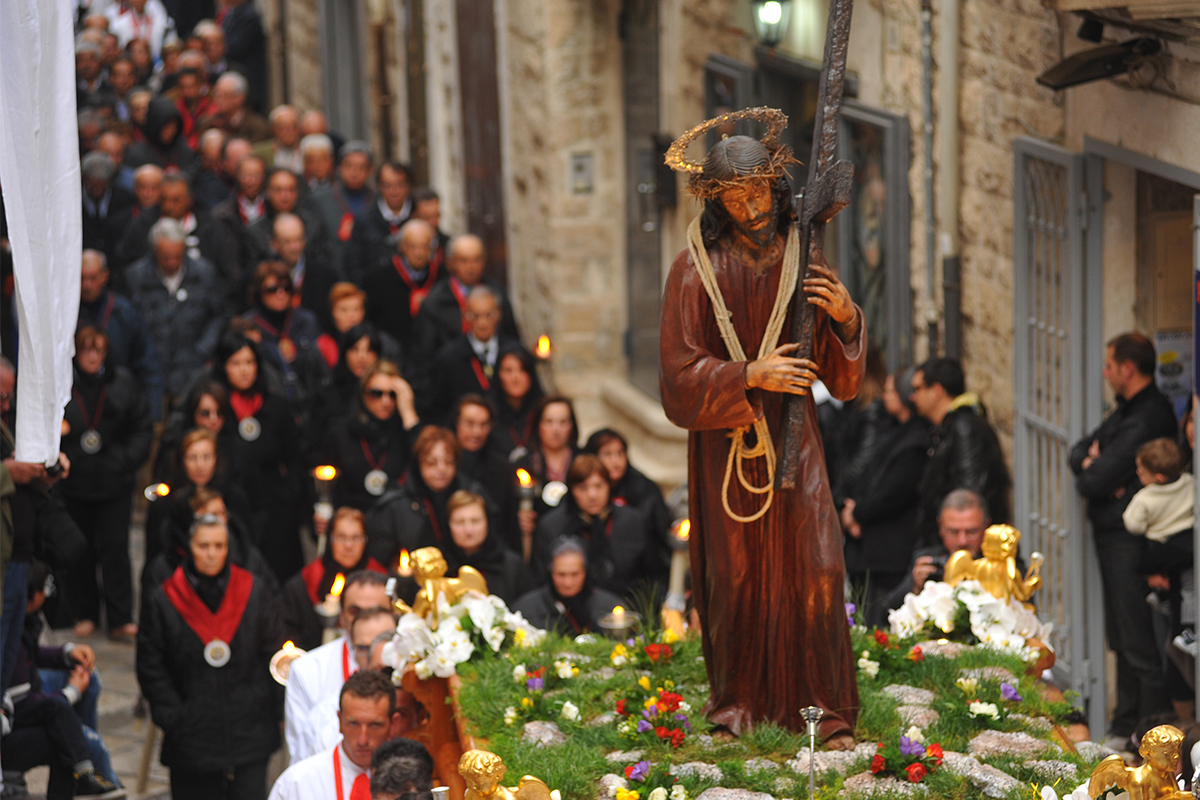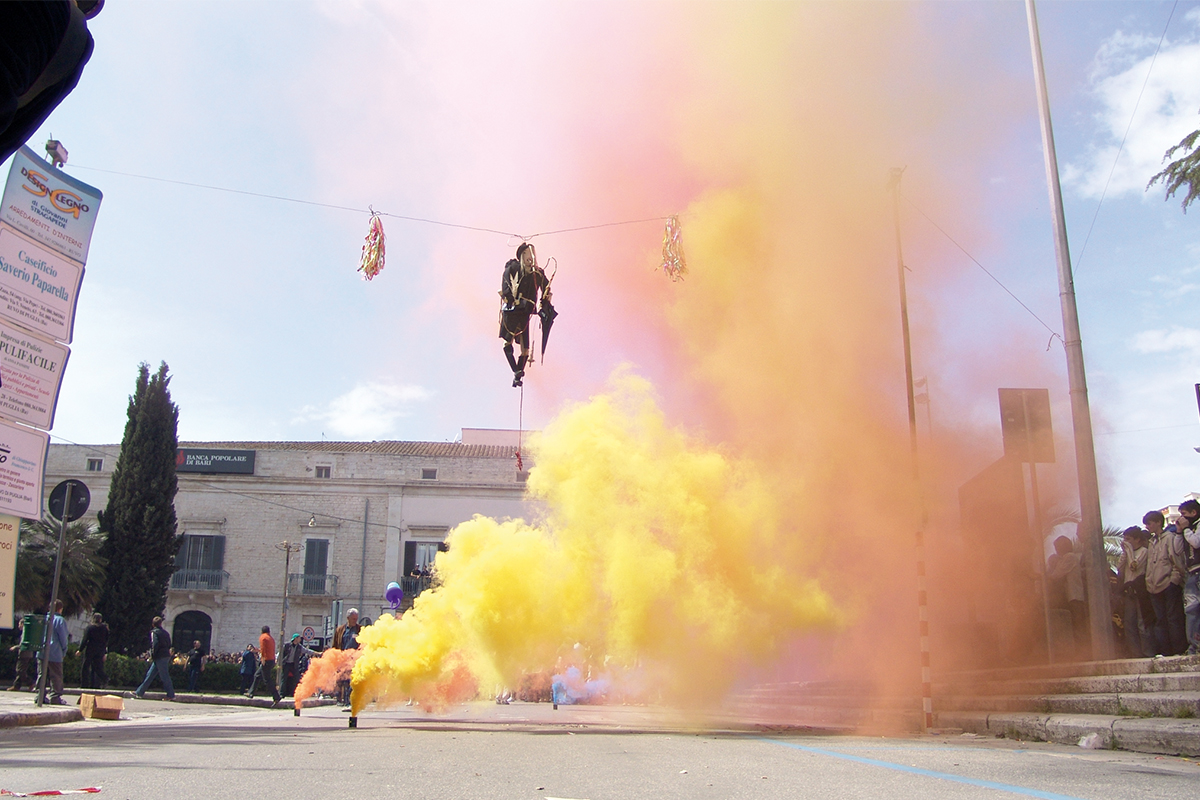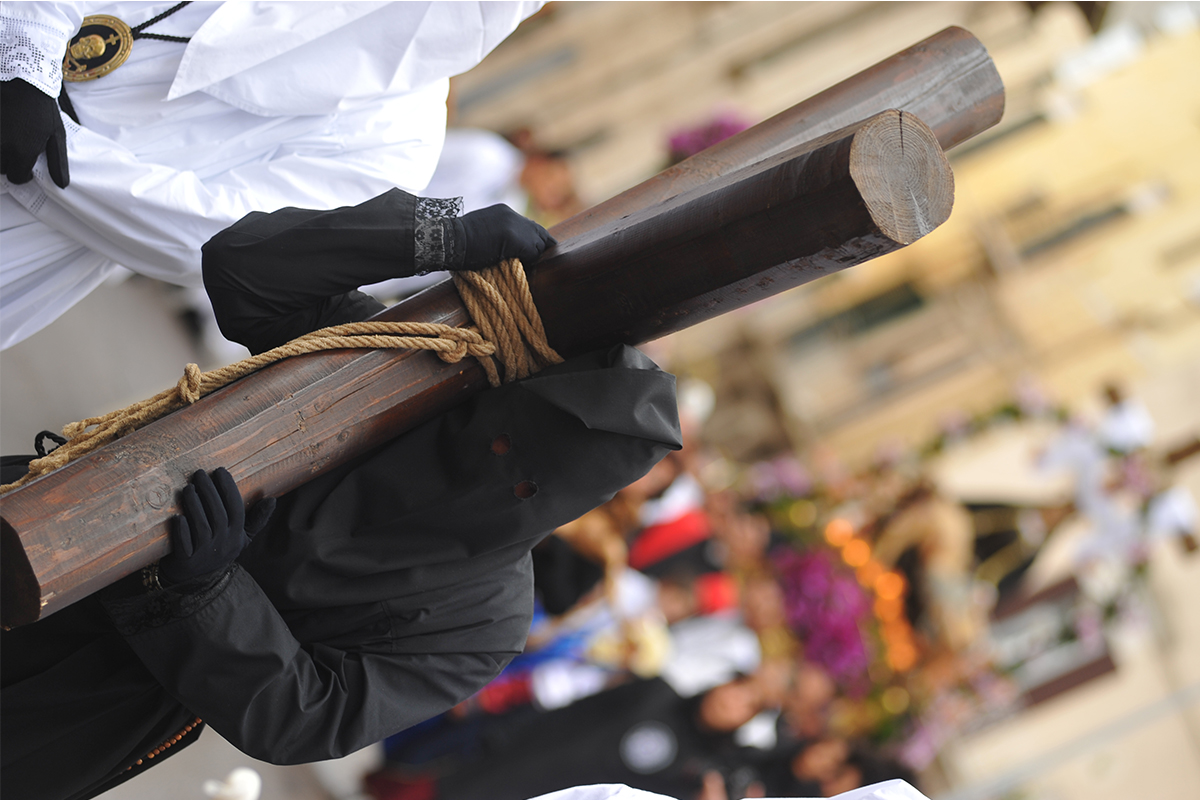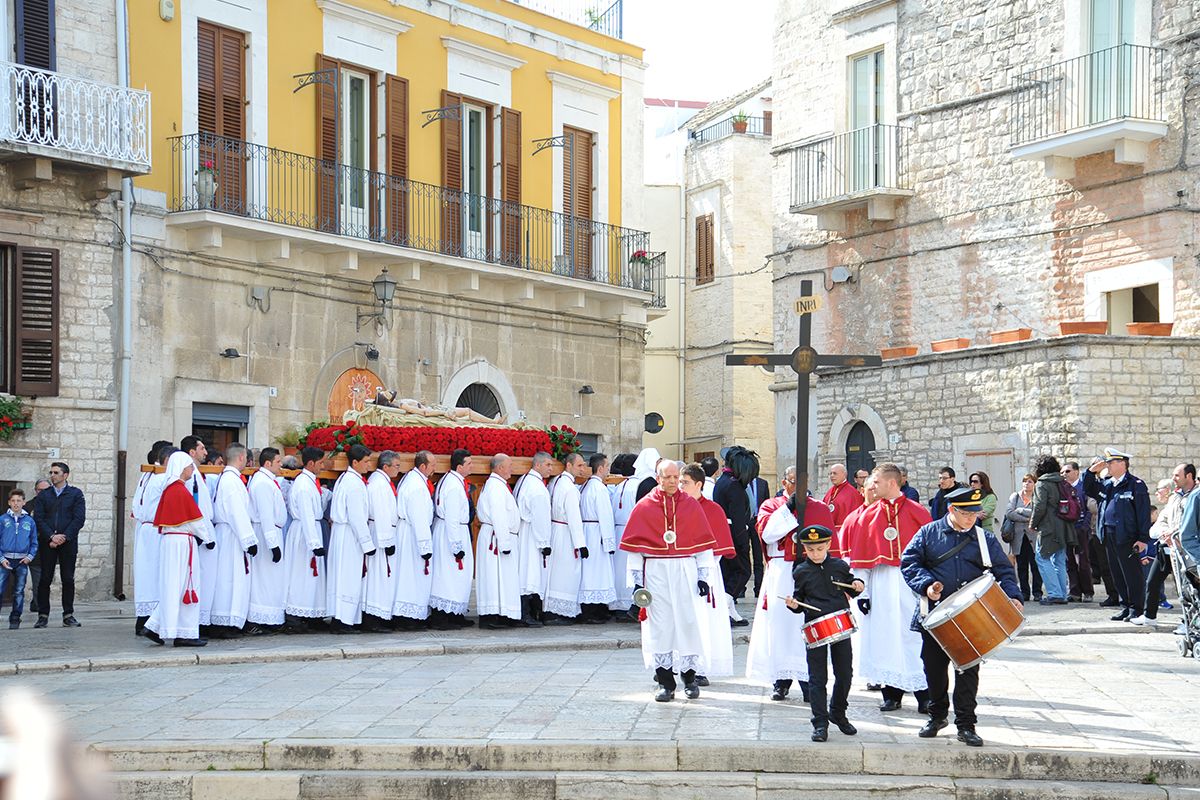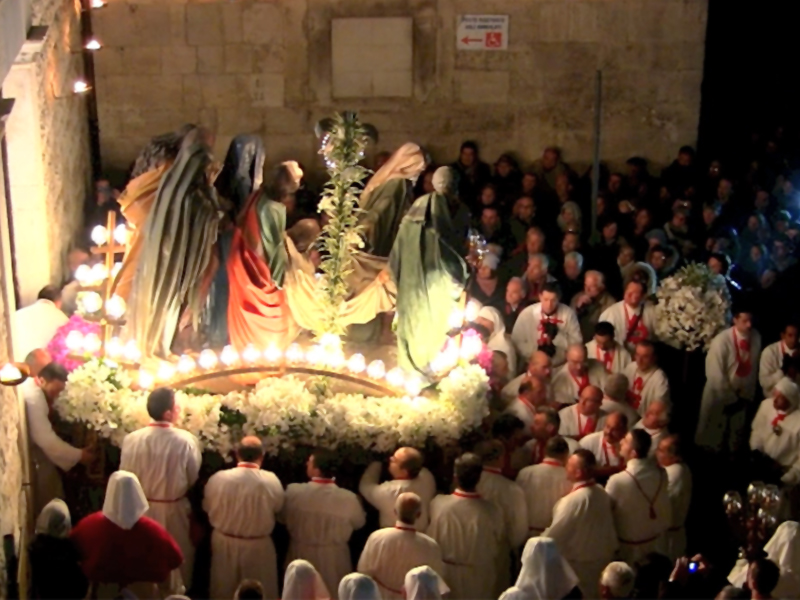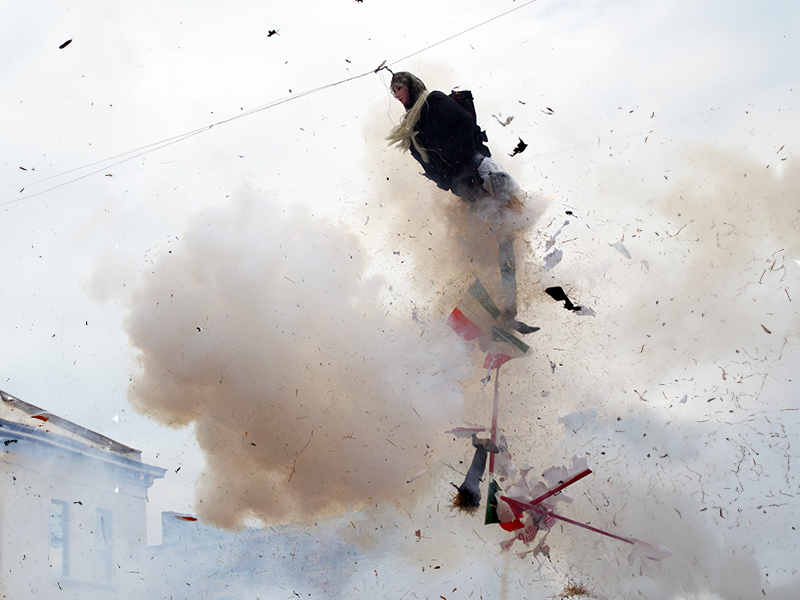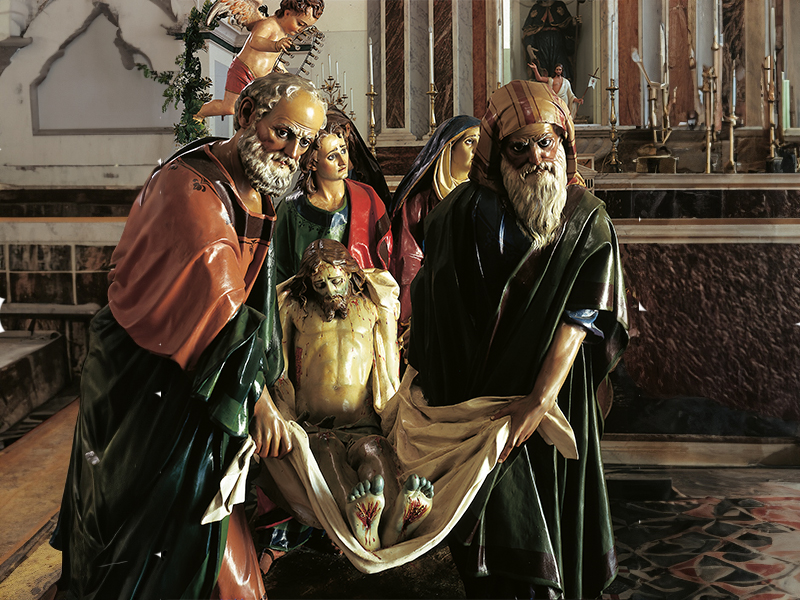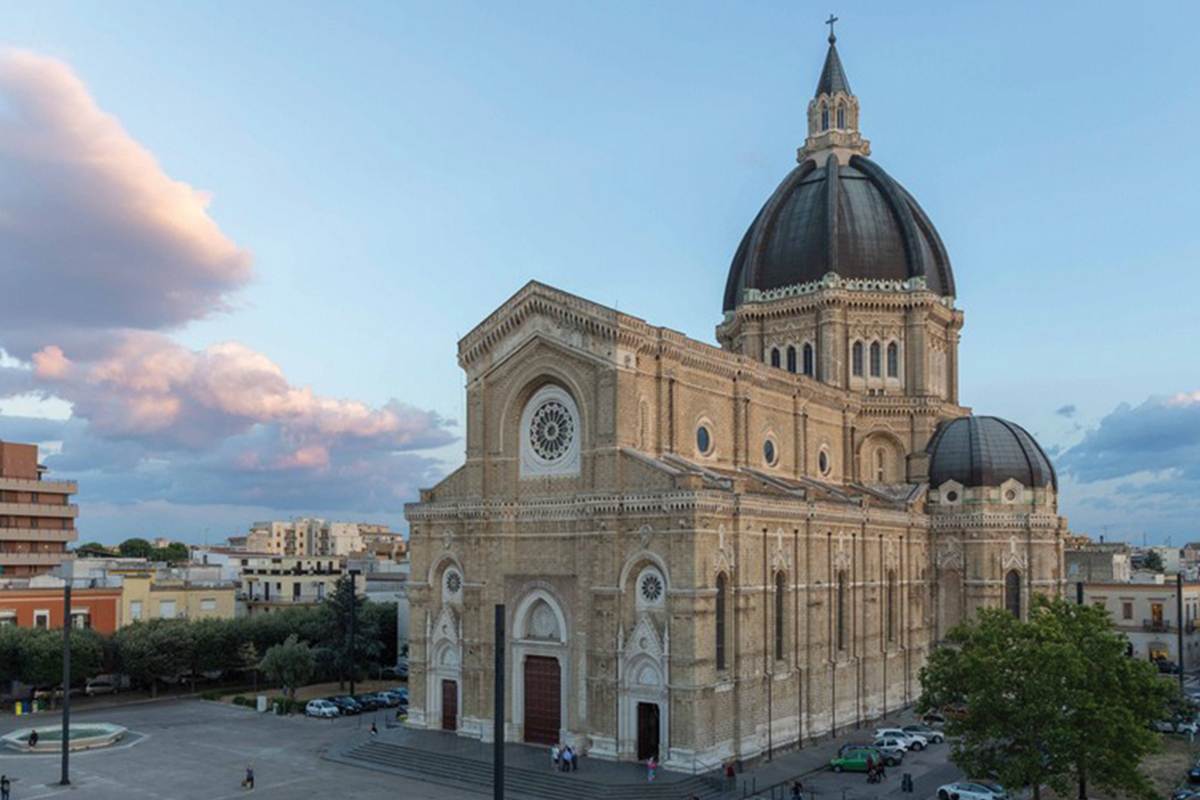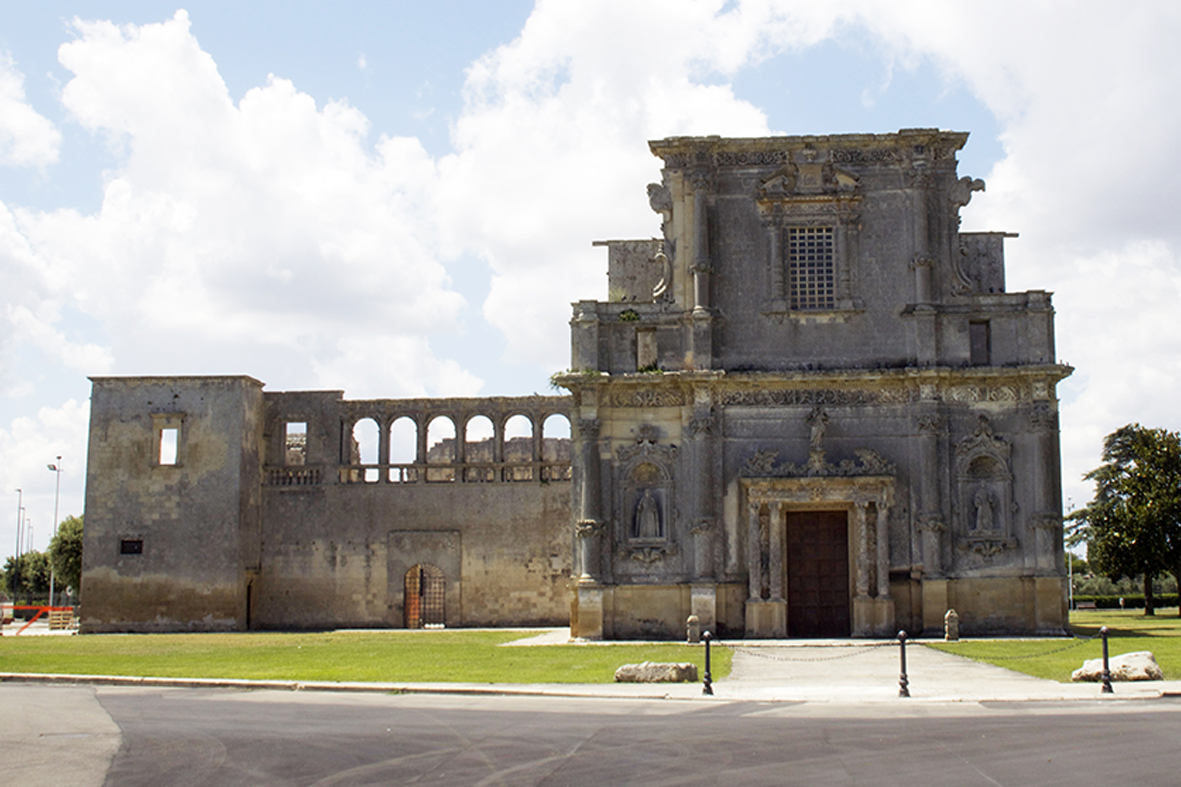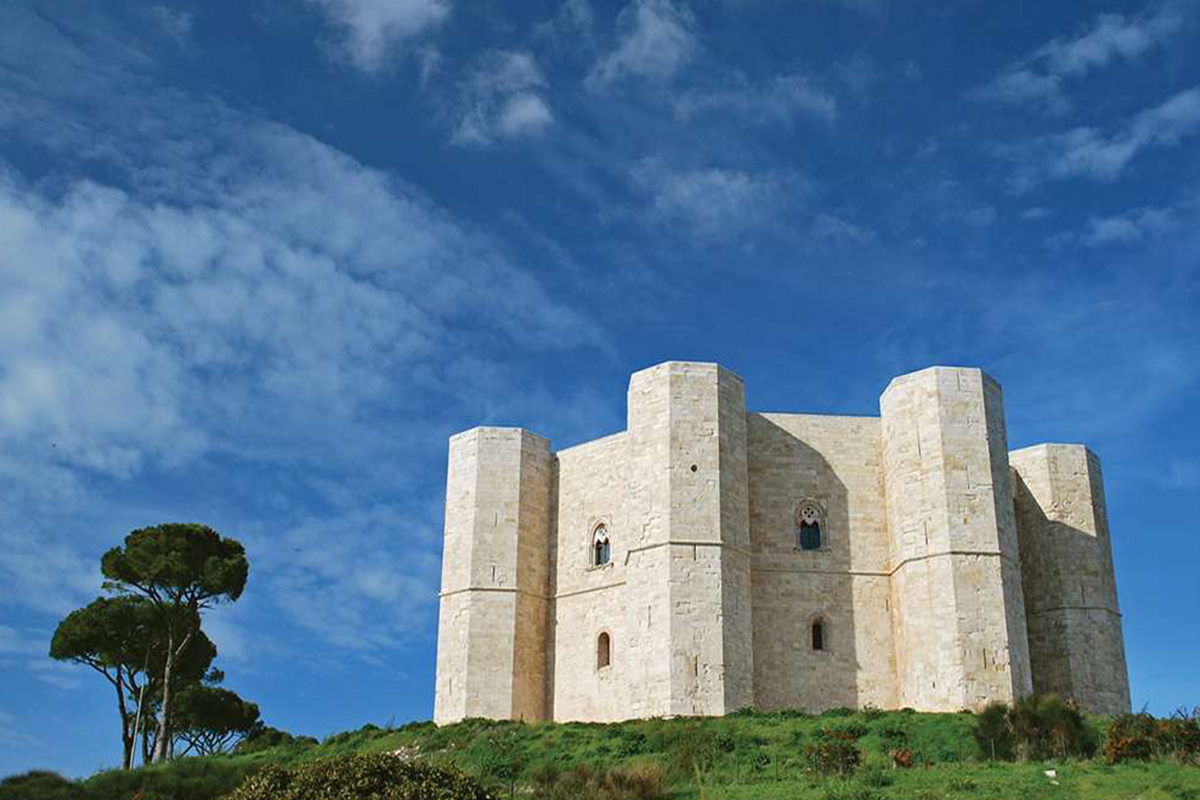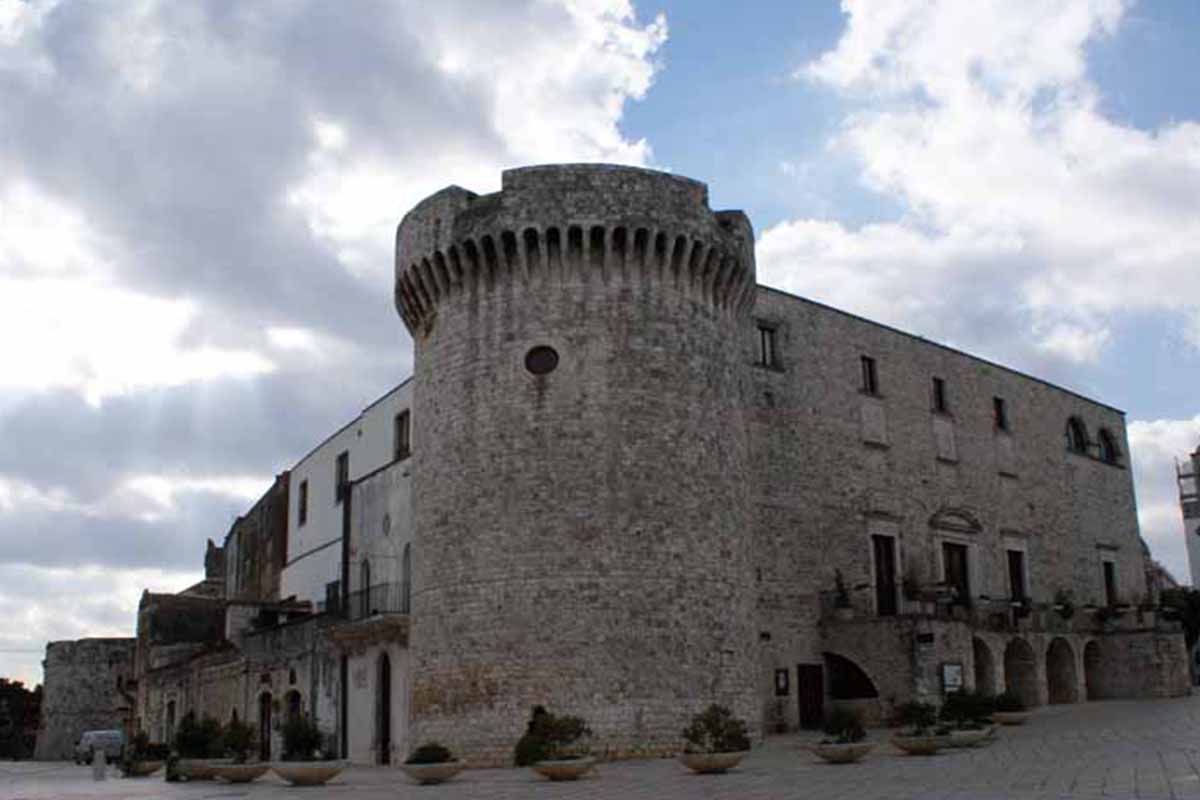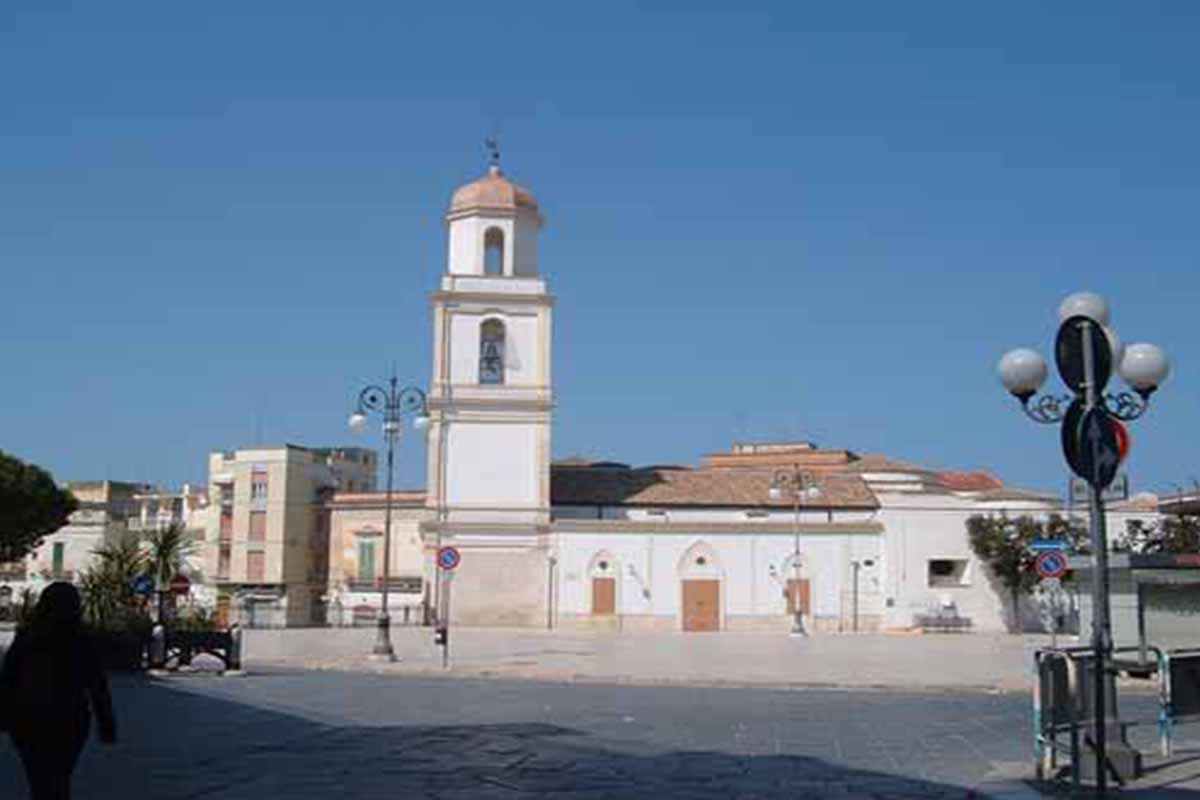Cities
the EIGHT SAINTS
09 Dicembre 2024
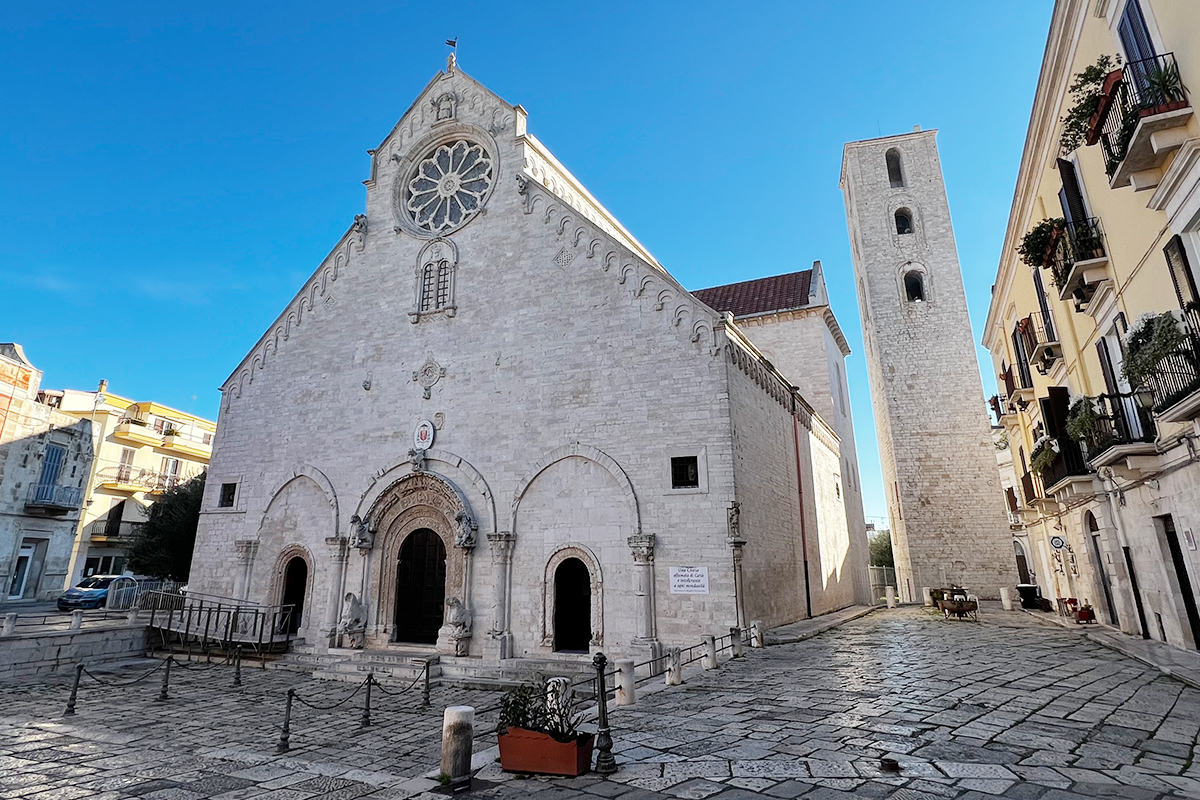
A city of art recognised as such by the Apulia Region, Ruvo di Puglia began its history in the Neolithic period, but the most widespread settlement forms date back to the Iron Age. From the 6th century B.C. onwards, there was a Hellenisation of the local Peucete communities, evident in the furnishings accompanying the aristocratic burials, valuable figurative ceramics of Attic import or of local manufacture, famous throughout the world.
The town grew during the Roman period with its status as municipium, while the Romanesque cathedral was built in the Middle Ages between the 12th and 13th centuries with its peculiar accentuated slopes and its hypogeum.
In the Church of Purgatory, traces of the late Roman period emerge: a cistern of a thermal complex where the first Christians gathered, known as the Crypt of San Cleto.
The Castle consists of a tower of probable Norman foundation and three lower bodies arranged around an atrium, which is accessed through the Melodia Arch.
The Jatta National Archaeological Museum , with its characteristic 19th-century layout, is a treasure trove of the city's archaeological evidence. Among its more than two thousand exhibits, it preserves the extraordinary Talos crater, made at the end of the 5th century BC. Another site of cultural importance is the monumental complex of the former Dominican Convent dating back to 1560, formerly the Municipal Gallery of Contemporary Art, where the new Archaeological City Museum will be inaugurated this year.
The Clock Tower, built in 1604, has an epigraph walled into its walls that dates back to the municipal period of ancient Rubi.
Noble palaces include Palazzo Spada, Palazzo Caputi, home to the Museum of the Book - House of Culture, which houses the Testini Library, and Palazzo Avitaja, home to the Town Hall, all built between the 16th and 17th centuries.
On a naturalistic level, the Vagno Caves, the most important karst system in the area, and the Alta Murgia National Park, established in 2004, of which Ruvo di Puglia is one of the thirteen municipalities that make it up, as well as the actual gateway, are worthy of note.
Among the best-known traditions is Holy Week with its processions and funeral marches performed by local bands. On Easter Sunday, the Quarantane, puppets dressed in black that in local tradition represent the Carnival wife, are blown up.
Also well-known is theCorpus Domini Octave festival, linked to historical events in the town according to an undocumented oral tradition.
The Sagra del Fungo Cardoncello (Mushroom Festival ) in November is one of the most important events in the area to promote food and wine activities.
The Patron Saint Biagio celebrations are held on 3 February.
Talos Festival at the beginning of September is among the longest-running and most appreciated musical and multicultural festivals in Apulia, while Luci e suoni d'artista is a participatory public art project conceived in 2016 and already in its seventh consecutive edition.
Places to visit: Old Town, Co-Cathedral of Maria Ss Assunta, San Cleto Crypt and Purgatorio Church, Jatta National Archaeological Museum, former Dominican Convent, Clock Tower, Palazzo Caputi, Alta Murgia National Park.
Useful contacts:
Ruvo di Puglia Regional Tourist Infopoint
-Address: Via Vittorio Veneto, 44, 70037 Ruvo di Puglia (BA)
-Telephone: +39 080 3628428
-Email: prolocoruvodipuglia@libero.it
Municipal Police of Ruvo di Puglia
-Telephone: +39 080 3611225
Venerdì di Passione
Processione della Desolata
The Processione della Desolata, organized by the Confraternita della Purificazione Addolorata, departs on the afternoon of Venerdì di Passione from the Chiesa di San Domenico. The statue portrays the Madonna dressed in mourning garments, suffering at the foot of the Cross, and processes through the streets of the town in an atmosphere of deep reflection and prayer.
-Date: April 11, 2025
-Time: 5:00 PM
-Location: Chiesa di San Domenico
Giovedì Santo
Processione del Trasporto al Sepolcro o degli Otto Santi
The night of Giovedì Santo is marked by the evocative Processione degli Otto Santi, organized by the Confraternita di San Rocco. The group of statues, crafted in the early 20th century by a papier-mâché artist from Lecce, represents:
1. Giuseppe d’Arimatea and Nicodemo, holding the edges of the shroud with the body of Jesus.
2. San Giovanni, the Madonna, Maria Maddalena, and two other pious women.
The procession begins at the Chiesa di San Rocco in the early hours of the night, illuminating the town with devotion that reaches its climax at 9:00 AM.
-Date: April 17, 2025
-Time: 2:00 AM - 9:00 AM
-Location: Chiesa di San Rocco
Venerdì Santo
Processione dei Misteri
The Processione dei Misteri, held on the afternoon of Venerdì Santo, represents the most significant moments of Christ's Passion. Departing from the Chiesa del Carmine, it features seven groups of statues:
1. Madonna Addolorata, dressed in black and pierced by a dagger (carried by fifty men).
2. Gesù legato alla colonna, Jesus bound to the column and scourged.
3. Cristo Portacroce, Jesus carrying the Cross, followed by numerous barefoot devotees.
4. Gesù Crocifisso, Jesus Crucified.
5. Gesù Morto, the Dead Christ.
6. Legno Santo, the reliquary of the Holy Cross.
Accompanied by funeral marches, the procession winds through the streets of the town, creating an atmosphere of profound devotion.
-Date: April 18, 2025
-Time: 5:30 PM
-Location: Chiesa del Carmine
Sabato Santo
Processione della Pietà
The Processione della Pietà, organized by the Confraternita di Santa Maria del Suffragio, takes place on the afternoon of Sabato Santo. Departing from the Chiesa del Purgatorio, the statue group portrays the Madonna holding the Dead Christ in her arms, in a scene of heartrending sorrow and emotion.
-Date: April 19, 2025
-Time: 4:30 PM
-Location: Chiesa del Purgatorio
Domenica di Pasqua
Processione di Gesù Risorto e Scoppio delle Quarantane
On Easter morning, the Processione di Gesù Risorto begins at the Chiesa di San Domenico, organized by the Confraternita della Purificazione Addolorata. The procession is accompanied by joyful children waving colorful flags.
During the procession, in a symbolic gesture, the Quarandone, a puppet symbolizing the penances of Lent, is exploded. Its destruction celebrates the victory of life over death, spring over winter, and joy over sacrifice.
-Date: April 20, 2025
-Time: 9:30 AM
-Location: Chiesa di San Domenico
Friday of Passion / April 11, 2025
• RUVO DI PUGLIA / Procession of the Desolata / Chiesa S. Domenico / 5:00 PM
Holy Thursday / April 17, 2025
• RUVO DI PUGLIA / Procession of the Deposizione (Deposition) or the Otto Santi (Eight Saints) / Chiesa di San Rocco / 2:00 AM
Good Friday / April 18, 2025
• RUVO DI PUGLIA / Procession of the Misteri (Mysteries) / Chiesa del Carmine / 5:30 PM
Holy Saturday / April 19, 2025
• RUVO DI PUGLIA / Procession of the Pietà / Chiesa del Purgatorio / 4:30 PM
Easter Sunday / April 20, 2025
• RUVO DI PUGLIA / Procession of Gesù Risorto (Risen Jesus) – Scoppio delle Quarantane (Explosion of the Quarantane) / Chiesa di S. Domenico / 9:30 AM
CONFRATERNITA DELLA PURIFICAZIONE E DI NOSTRA SIGNORA DEI DOLORI
Founded at the end of a popular mission by Jesuit Domenico Bruno in 1719 as a congregation of rural workers (day laborers or farmhands), it was dedicated to the Purification of the Virgin and Saint Ignatius of Loyola. The events related to the expulsion of the Jesuits from the Kingdom of Naples in 1767 and the suppression of the order led to the temporary inactivity of the confraternity, which was reorganized with new rules in 1777, the year it received royal recognition from Ferdinand IV. In 1810, the confraternity moved to the Church of the Most Holy Rosary, known as San Domenico, contributing to the architectural and decorative renewal of the religious building. In 1833, with papal approval, the title of Nostra Signora dei Dolori (Our Lady of Sorrows) was added to the Purification. Since its foundation, the confraternity has been particularly devoted to acts of worship and practices in honor of the Virgin of the Seven Sorrows, beginning with the Passion Friday procession, which takes place before Palm Sunday. The statue of the Virgin, known as La Desolata, was created in 1907 by the artist Corrado Binetti from Molfetta, following expressive forms dear to popular devotion: the Virgin, with a youthful face and dressed in black, stands at the foot of the cross, embracing it; at the height of her heart, a golden sword is embedded, symbolizing the prophecy of the elder Simeon. On Easter Sunday, in a festive atmosphere, the same confraternity organizes the procession of Gesù Risorto (Risen Jesus), during which the ancient agricultural ritual of the Scoppio delle Quarantane (Explosion of the Quarantane) takes place.
CONFRATERNITA DI SAN ROCCO
The first known reference to a confraternity dedicated to the thaumaturge saint of Montpellier is an inscription in the chapel of San Rocco, located in the current main square, which recalls the perpetual indulgence granted by Gregory XIII in 1576 to the church and confraternity of San Rocco in Ruvo. In the oldest archival documents, the confraternity is described as poor due to the social background of its members, mostly peasants. All the confreres who, in 1781, obtained royal approval of their rules and foundation from Ferdinand IV were illiterate and signed with the sign of the cross. The life of the confraternity was marked by deep devotion and solidarity among its members, who, despite their poverty, did not fail to engage in charitable works through the Monte San Rocco. Today, the confraternity, in addition to promoting devotion to its patron saint and to Madonna del Buon Consiglio (Our Lady of Good Counsel), to whom it dedicates a feast in April, organizes the striking procession of the Otto Santi (Eight Saints) on the night between Wednesday and Holy Thursday. During this event, an imposing group representing the Transport of Jesus to the Sepulcher, with life-size statues, parades through the streets, flanked by rows of faithful on both sides. The complexity of the structure, carried on the shoulders by fifty bearers, and the dramatic nature of the scene make this procession an extremely evocative symbol of Ruvo’s Easter celebrations.
ARCICONFRATERNITA DI NOSTRA SIGNORA DEL MONTE CARMELO
The archconfraternity was established in 1604 through the initiative of zealous priests and pious citizens, and it was based in the ancient benefice church of San Vito, since then known as Nostra Signora del Monte Carmelo (Our Lady of Mount Carmel). The social composition of its members was the foundation of the power that the confraternity wielded over the centuries and of its significant patrimonial and economic resources. These valuable assets were invested in the expansion and enrichment of the church and the confraternity’s oratory, the latter located on Via Strignatora, where the confreres gathered for acts of devotion and penance as well as for administrative matters. In 1763, the confraternity received legal recognition of its rules and foundation, as required by royal legislation on lay associations. The confraternity also managed the so-called Monte Barese, established with its own assets by notary Carlo Barese. Since the 17th century, it has organized the Processione dei Misteri (Procession of the Mysteries), which takes place on the night of Good Friday, featuring several wooden sculptures of Christ and the Virgin, culminating with the relic of the Holy Cross. Of great emotional impact is the venerated statue of the Cristo portacroce (Christ Bearing the Cross), sculpted in wood in 1674 by Filippo Altieri; in the procession, it is followed by dozens of barefoot penitents fulfilling a vow.
CONFRATERNITA DI SANTA MARIA DEL SUFFRAGIO
In the first half of the 17th century, a second nave was added to the ancient church of San Cleto, initially dedicated to Saint Michael and later to Madonna del Suffragio (Our Lady of Suffrage), whose painted image, a work by the Neapolitan artist Plantamura, was placed on the main altar. The confraternity was canonically erected in 1678 and affiliated the same year with the Archconfraternity of Suffrage in Rome, in order to benefit from the spiritual privileges granted by the popes. Its main purpose was the care of the cult of the deceased and the souls in purgatory. Among the assets it managed was the Monte dei Morti (Mount of the Dead), which, in just a few years, became one of the city’s wealthiest pious institutions. According to the wills of numerous benefactors, its revenues were used for masses of suffrage and worship, as well as for various charitable initiatives to assist the needy and the sick. Perhaps inherited from the defunct confraternity of San Cleto, the Monte San Cleto managed several land properties for charitable purposes. Another institution administered by the confraternity was the Monte Leone, founded by Francescantonio Leone in 1711. The establishment of the Processione della Pietà (Procession of the Pietà) dates back to the late 19th century, while the statue of the Virgin holding her dead Son on her lap was created in 1901 by the renowned sculptor from Lecce, Giuseppe Manzo. This moving statue is accompanied, on the evening of Holy Saturday, by hundreds of confreres dressed in white, wearing a diagonal black sash adorned with the symbol of death.
The cuisine of Ruvo di Puglia reflects the Apulian gastronomic tradition, based on simple and authentic ingredients. Local extra virgin olive oil plays a starring role in many dishes, thanks to the vast olive groves surrounding the city.
Among the typical dishes, the highlights include orecchiette with turnip greens, braciole al sugo (meat rolls in tomato sauce), and the calzone di cipolle, a focaccia stuffed with onions, olives, and anchovies. The bread of Ruvo, made with local wheat, is particularly renowned.
The confectionery tradition features purcedduzzi (small fried dough balls coated in honey), typical of the Christmas season, and scarcelle, Easter pastries shaped like baskets and decorated with hard-boiled eggs.
The city also boasts a significant wine production, with DOC wines such as Castel del Monte, perfect for pairing with the traditional local dishes.
Cities Info

Municipality of Ruvo di Puglia
T + 39 080 950 7111
Municipal Police
T +39 080 361 1225
Pro Loco Ass. Turistica UNPLI
T +39 080 361 5419
Highlighted Municipalities


 it
it en
en fr
fr es
es de
de pt
pt